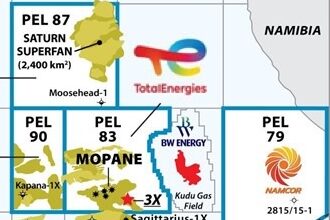Outlook 2012: Despite recession fears, industry on track for promising-to-bullish year
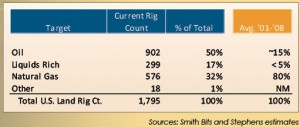
Supply/demand likely to keep drilling levels high; US onshore rig count expected to increase by 15%
By Katie Mazerov, contributing editor
Amid macro-economic uncertainty and market volatility, analysts are putting the industry on a promising-to-bullish track for 2012 as oil prices remain solid, rig counts rise and the offshore industry turns the tide from the doldrums it was in a year ago.
Despite a downturn in North American shale gas production, most industry watchers are seeing an uptick in activity as evidenced by significant discoveries in the North Sea and Gulf of Mexico (GOM), the continued ramp-up offshore Brazil, steady growth in the West Africa and Asia Pacific markets, and an active and growing international liquefied natural gas (LNG) trade.
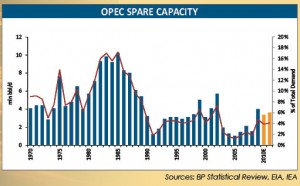
After a year marked by post-Macondo jitters, heightened regulations and the Arab Spring, analysts believe the industry is ready for a healthy return to stable growth.
“In investors’ minds, macro fears are trumping everything else at this point, whether it’s slowing economic growth, the potential for recession or fears about European debt,” said John Keller, vice president and oilfield services research analyst for Arkansas-based financial services firm Stephens Inc. “But through all these fears, when you look at oil prices, the global outlook for drilling activity as we go into 2012 remains pretty promising.”
From a supply and demand perspective, international supply remains challenged, he said. “The fallout from the split among the OPEC countries earlier this year, with Saudi Arabia moving forward with development plans in light of desired production cuts by other OPEC members, hasn’t fully started to ramp, yet. That will underpin growth in that region, as will continued development in Iraq.”

There is some uncertainty about the impact on supply and oil prices by the anticipated return to production in North Africa following the Arab Spring. “The wild card is how quickly Libya will recover,” said Marshall Adkins, managing director of energy research at Raymond James & Associates.
“But even when we factor Libya coming back online mid-2012 and a global recession, which implies the OECD (Organization for Economic Cooperation and Development) will be in recession, the global oil model is just about as bullish as I’ve seen in decades.”
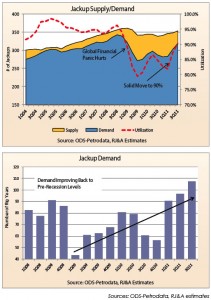
Barring a severe recession emanating from Europe, supply and inventories are low enough to keep oil prices firm, he added. Oil prices also will hold up if governments opt to print more money in response to over-leveraged situations.
“Fundamentally, from a supply/demand standpoint and from a global money situation, oil will continue to be the main driver of activity, particularly in North America, where drilling is expected to see double-digit growth, mostly in the liquids-rich and oil plays,” Mr Adkins said.
Due to typically slower growth rates, the international market will see growth of 6% to 9%, he continued. Higher natural gas prices in most international markets will support continued production in shale and other unconventional gas plays, particularly in Australia and South America.
The global jackup market is poised for a rebound, as utilization has increased from 82% to 90%, signaling an increase in rig pricing, Collin Gerry, vice president, Oilfield Equity Research at Raymond James. “Almost all jackup activity is driven by Brent oil prices, which have remained above $100/bbl,” Mr Gerry said.
Asia and the Middle East lead the jackup market. “Currently, there are 100 jackups in Asia, including India, China and Southeast Asia, which is at the high end of the historic demand range,” he noted.
“The nuclear disaster in Japan and moves by Germany to shut down reactors also will bolster the outlook for LNG,” Mr Keller said. “Oil prices are the driver for international activity simply because LNG internationally tends to be priced off oil prices or some function of oil prices.”
Gulf of Mexico
Oil will continue to be the focus of activity in the GOM, but ongoing and heightened regulations and the still-slow pace by the US government to issue permits cloud the post-Macondo picture.
“The GOM remains a political football on outlook, but it will really boil down to how quickly permits continue to be issued, and sustainability of the level of permitting will determine how that market plays out,” Mr Keller said. “When you’re a major operator looking out across the globe, where access to hydrocarbons is becoming more restricted due to geopolitical events and nationalization, the GOM still looks very good and the resource potential is there.”
A positive development has been the recent large ultra-deepwater discoveries by ExxonMobil, Chevron and BHP Billiton in the highly pressurized Lower Tertiary geological formation.
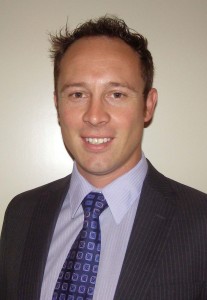
“Even before 2010, we saw companies reducing their exploration and appraisal drilling campaign budgets,” said Dane Groeneveld, regional director for NES Global, which provides engineering services and specialist staff support for the energy industry worldwide. “The situation was already difficult; then Macondo happened.
“But we are seeing a return to more work in the Gulf, with operators allocating more time and resources in the geoscience departments for future developments,” he continued. “As a result, we are seeing an increase in rig rates and support for more drilling going into 2012.” NES Global is being asked to find development geologists, reservoir engineers and drilling engineers for work on developing assets in these leases. “The uptick this year will be a continuing trend over the next few years,” Mr Groeneveld said.

Permitting remains an issue, however. The active deepwater rig count in the Gulf had moved up to more than 20 by early October, higher than it was last year but still well below pre-Macondo levels. “We’re seeing a lot of interesting prospects with significant potential, but because of the government’s slow pace in issuing deepwater permits, we haven’t been able to move these discoveries and previous discoveries forward, which is disappointing,” said Philip Weiss, senior analyst, energy for Argus Research.
“Operators are sitting on a lot of nonproductive capital because they can’t get these projects moving,” he continued. “We have 23 (active deepwater) rigs in the Gulf now, but there are questions about what will happen when that work is completed. There is not a pipeline of other projects with permits in place. That increases the risk that rigs could once again be realizing reduced dayrates while waiting for work. Both operators and rig owners suffer under those circumstances.”
Meanwhile, new regulations mandating such activities as unannounced spill drills and stronger disclosure requirements have been implemented. On 1 October, the US Bureau of Ocean Energy Management, Regulation and Enforcement (BOEMRE) split into two agencies. The Bureau of Safety and Environmental Enforcement (BSEE) will be responsible for inspections, enforcement and safety of offshore oil and gas operations. The Bureau of Ocean Energy Management (BOEM) will oversee energy leasing and planning on the Outer Continental Shelf (OCS), along with offshore leasing, resource evaluation, review and administration of oil and gas exploration and development plans.
Shale – shift to oil continues
The disparity of oil prices holding steady at $80 or above and low natural gas prices continues to drive the shift by North American operators from dry gas plays to reservoirs characterized by a mix of hydrocarbon gas and natural gas and liquids and/or oil. The expected drop in the gas rig count will be offset by the increase in the oil rig count, with the overall US rig count expected to increase by approximately 15% next year, then 10% to 12% annually for the next few years, Mr Adkins noted. “Canada will mirror that trend,” he added.
Ironically, the technologies developed for dry gas plays are driving the growth in liquids plays such as the Bakken and Eagle Ford, both showing a marked increase in rig counts. “In a very rational way, the industry is chasing oil prospects with the technology it developed for the Barnett, Haynesville and Woodford plays that are now seeing a downturn,” Mr Keller said. “Five years ago, roughly 80% of the rig count in the US was deployed in natural gas plays. Now, it’s much more of an even split.”
Also significant is the horizontal component of the oil rig count. “Today, more than half of the oil rig count is drilling horizontally, compared to 25% to 30% at the beginning of 2008,” he noted.
Data from Smith Bits STATS show the Eagle Ford rig count at 213 in early October, up from 134 at the end of 2010, and the Bakken count up to 191 from 157, Mr Keller noted. The same is true in the Permian Basin, where Smith Bits puts the rig count at 330, from 258 at the end of last year. “The Permian Basin has been a significant growth area for the US in 2011,” he noted. “While the play is generally considered conventional, it has some unconventional formations, and operators are using a lot of horizontal drilling and hydraulic fracturing technology to access multiple zones in one wellbore.”
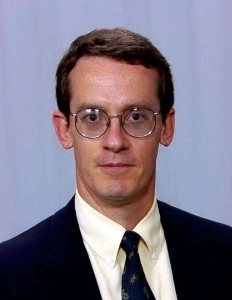
Overall, activity in the Eagle Ford, Bakken and Permian Basin will see a 20%-plus growth in 2012, said John Spears, president of Spears & Associates, who agrees that the adoption of shale gas technology has been significant. “Nearly 100% of the drilling in the Bakken and Eagle Ford plays is horizontal,” he said.
Mr Spears projects there will be 2,100 active land drilling rigs in the US in 2012, up from about 1,880 active rigs this year, with utilization around 70%, up from 64%. “The count will include 200 new rigs, most of them high-spec, advanced technology rigs for horizontal and deviated drilling,” he said. He predicts gas drilling will fall 2% to 3% next year as operators continue to migrate from dry gas to other markets.
“US operators also are seeing well costs rise 15% to 20% per year, and dayrates are up about 20% over a year ago, due in part to the growth in advanced-technology rigs,” Mr Spears noted. “The biggest increase in well costs will come from hydraulic fracturing operations, which are up 40% due to tight availability and lead times for crews, and to some degree, environmental issues.”
In Canada, the rig count will increase 8% to 10%, with the total active rig count around 460 in oily plays, he continued. Alberta, which includes the Cardium and Duvernay plays, will continue to account for two-thirds of that, followed by Saskatchewan, which includes a portion of the Bakken formation, then British Columbia.
Beyond North America
The North American shale boom has spread to several international markets, including Southeast Asia, Latin America and Europe, thanks to more favorable international natural gas prices and the export of technology. “The US has been the incubator for the world, and now we’re starting to see emerging markets link up with Western companies,” Mr Spears said. “Because of the active LNG market and international pipelines, international gas prices are up to three times higher than they are in North America. “
In Asia Pacific, Australia, with extensive shale reserves in the Canning Basin, has emerged as the most aggressive player in the shale sector, said Usman Ahmed, vice president and chief reservoir engineer, Reservoir Development Services for Baker Hughes. The country is engaged in an ambitious program to develop shale natural gas resources for export into Southeast Asian markets. Australia’s risked gas in place (GIP) is estimated at 1,381 TCF.
China and India, with risked GIP estimated at 5,000 TCF and 500 TCF respectively, hold extensive shale gas reserves; however, it is anticipated that India will develop faster than China, Mr Ahmed said. “The Indian government has sent out requests for proposal and expects to be drilling the first shale gas wells by mid-2012,” he said. The primary shale basins are located in the country’s northwest and southern regions. Baker Hughes also is working with the Indonesian government on some pilot wells.
“Shale development in China is hindered by two main problems,” Mr Ahmed noted. “The country’s highly populated areas make production more logistically challenging. Even greater difficulties are encountered because most of the shale basins in China are located in areas where there is a significant lack of water, for example, in the Tarim Basin.”
The latest region to enter the shale market is Latin America, most notably Argentina, where the risked GIP is estimated to be 2,732 TCF, and Mexico, where the risked GIP is estimated to be 2,362 TCF. Activity is also anticipated in Brazil, Chile and Bolivia. Halliburton executed the first horizontal, multi-stage hydraulic fracture shale gas completion in Argentina’s Neuquén Basin for Apache Energy in August this year.
All regions are expected to outpace Europe, where extensive shale reserves exist, but production is much slower due to more stringent regulations, Mr Ahmed noted. Poland, where the Baker Hughes rig count was nine at the end of September, is currently the major European shale producer. Risked GIP in the country is estimated at 792 TCF. “Discussions to develop shale in Poland began about three years ago, and the country is now the most active on the continent, primarily because of the government’s energy-friendly policies and willingness to eliminate red tape,” he said.
Cuadrilla Resources, an independent oil and gas company in the UK, recently announced the discovery of a 200-TCF shale gas formation in the Bowland play in northwest England. The company reportedly will submit a development plan to the government in 2012 and hopes to begin production in 2013.
But the big challenge for international shale development is equipment, Mr Ahmed continued. “Regardless of how promising the shale reservoirs are in these regions, there is a severe shortage of equipment from the service sector,” he said. “Manufacturing can’t keep pace with demand. The delivery timetable for frac trucks in North America is six to nine months but can be up to 17 months in other markets.” Lack of personnel remains an ongoing issue as well, but the equipment lag time is giving markets more time to ramp up the work force, he said.
North Sea
Exploration and potential recovery opportunities remain strong in the Norwegian sector of the North Sea. Estimates of recoverable assets for the Avaldsnes/Aldous oil and gas field, discovered on Norwegian Continental Shelf last year, have increased to 1.2 billion to 2.6 billion bbls, making it potentially the third-largest North Sea find and the largest since the mid-1980s. “We are now realizing the prospects for this field are huge,” said Andrew Vinall, technical director for UK firm Hannon Westwood. The field is situated in 115-meter water depths, with reservoir depth at less than 2,000 meters.
The discovery is boosting the overall outlook for the region, despite a reduction in drilling activity in the UK sector. “We feel the number of wells is going to hold up, especially in Norway,” Mr Vinall said. “There are more rigs under construction planned for in Norway than any other North Sea sector.” The active rig count in Norway as of early October was 32; no rigs are stacked, he said. “Utilization in northwest Europe is around 94% for jackups and 90% for semis.”
Several factors, including the surprise 12% tax increase implemented by the British government, have resulted in a major decline in exploration and appraisal (E&A) drilling in the UK sector, where the active rig count is similar to Norway, but with five rigs stacked, Mr Vinall said. Eleven rigs are on E&A wells.
While utilization has remained steady in the UK, more wells are being switched to development drilling. “Also, the UK Department of Energy and Climate Change has been slow to authorize wells this year, and several companies that had very active drilling programs in previous years have been acquired, and the new owners are not as active,” Mr Vinall said.
The region’s increasingly complicated geology, with deeper, high-pressure, high-temperature (HPHT) characteristics, means wells are taking longer to drill than in previous years, he indicated.
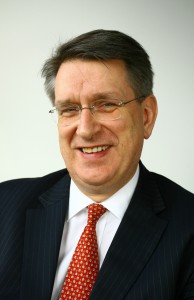
Operators are optimistic the UK tax situation can be relieved through incentives, according to Malcolm Webb, chief executive of Oil & Gas UK, an industry group representing the UK offshore oil and gas industry.
“Activity is relatively flat, and the exploration well count this year is particularly low,” Mr Webb said. “We haven’t seen a great exodus, but we are seeing a lot of dismay. The big projects with robust economics are still going ahead, but other, smaller projects are stranded, and we need to overcome that problem or we could see capital being attracted to other parts of the world in preference to the UK North Sea basin.” The basin still holds an estimated 24 billion bbls of oil and gas reserves.
The tax increase has impacted some of the smaller, more technically challenging plays, such as HPHT fields and marginally productive mature reservoirs, Mr Webb noted. “A number of gas projects have been impacted because the price of gas is roughly half the price of oil here.”
The UK government in March raised the corporate tax rate on UK oil and gas from 50% to 62%, and raised the marginal rate on the oldest fields (those that began producing before 1993) up to 81%.
“The government decided that in view of the current economic climate, it should scrap the ‘green tax’ that was designed to reduce demand by making fuel more expensive at the pump,” Mr Webb said. To replace that revenue, the government then imposed higher taxes on producers.
The industry is working with the government to come up with fiscal incentives that would spark incremental production and allow projects to move forward. “If we can come to some resolution on that and gain some bankable assurance from the government that it will pay its share of decommissioning costs, that will be a very positive move for the basin and will help us improve the attractiveness for investment,” Mr Webb said.
On the UK regulatory front, the Oil Spill Prevention and Response Advisory Group (OSPRAG) submitted its final report in September, with most of the recommendations already being implemented, including introduction of a device (see p14) that can cap a free-flowing well in a matter of days, Mr Webb said.
Of concern are moves by the European Commission to take centralized regulatory control over offshore oil and gas E&P operations in Europe. “We are in discussions about that now. We believe control should be left to national regulators who are already doing a very competent job,” he said.
Asia Pacific
Natural gas is the driver for growth in the Asia Pacific region, with Australia engaged in seven LNG projects targeted for Southeast Asian markets. The country’s aggressive coal seam gas (CSG) industry is fueling the growth on the East Coast, paralleling the North American shale gas boom, NES Global’s Mr Groeneveld observed.
“The big spike in hiring activity a few years ago has continued, and we are expecting another big spike at the back end of 2012. The activity is attracting drilling and oilfield service firms from as far afield as Canada, with the major service companies also ramping up their presence,” he said.
Drilling on Australia’s Northwest Shelf and the Timor Sea has also increased, along with developmental drilling in Papua New Guinea to support recent onshore and offshore exploration activity, Mr Groeneveld said. Offshore activity for gas drilling also is gearing up in Malaysia and Thailand. NES Global has offices in Singapore, Malaysia, Vietnam, Thailand and Indonesia, where there has been marked growth on the drilling side of the business. China remains an expanding market for onshore and offshore gas production, he said.
Africa
Operators and contractors in North Africa are anticipating a return to business as the region rebounds from the Arab Spring uprisings, which effectively shut down drilling in Libya. Companies also are exploring entry into Tunisia, where 20 rigs are operating, and continue to show interest in Algeria, a major supplier of natural gas for Europe.
Exploration activity in West Africa, with a number of deepwater fields in Equatorial Guinea, Nigeria, Mozambique, Angola and Ghana, has seen steady growth in the past year, thanks in part to the redeployment of idle rigs to the region from the GOM. “The deepwater potential makes West Africa one of the exciting new frontiers, mirroring Brazil,” Argus Research’s Mr Weiss said.
One of the most prolific is the Jubilee field offshore Ghana at a water depth of 1,250 meters. The field is estimated to hold recoverable reserves of more than 600 million bbls and an upside potential of 1.8 billion bbls.
With 35 active jackups in West Africa, utilization is somewhat challenged by geopolitical issues in some countries, Mr Gerry of Raymond James noted.
However, Mr Groeneveld said West Africa has been a big growth area for NES Global. “We’re seeing 40% year-on-year growth both from the major operators as well as smaller companies. We are placing a lot of professionals into exploration and development phases and for actual project execution for various facilities. We’re also seeing companies sending more environmental professionals and seismic crews to the region for early exploratory drilling and due diligence.”




